-
 Bitcoin
Bitcoin $106,754.6083
1.33% -
 Ethereum
Ethereum $2,625.8249
3.80% -
 Tether USDt
Tether USDt $1.0001
-0.03% -
 XRP
XRP $2.1891
1.67% -
 BNB
BNB $654.5220
0.66% -
 Solana
Solana $156.9428
7.28% -
 USDC
USDC $0.9998
0.00% -
 Dogecoin
Dogecoin $0.1780
1.14% -
 TRON
TRON $0.2706
-0.16% -
 Cardano
Cardano $0.6470
2.77% -
 Hyperliquid
Hyperliquid $44.6467
10.24% -
 Sui
Sui $3.1128
3.86% -
 Bitcoin Cash
Bitcoin Cash $455.7646
3.00% -
 Chainlink
Chainlink $13.6858
4.08% -
 UNUS SED LEO
UNUS SED LEO $9.2682
0.21% -
 Avalanche
Avalanche $19.7433
3.79% -
 Stellar
Stellar $0.2616
1.64% -
 Toncoin
Toncoin $3.0222
2.19% -
 Shiba Inu
Shiba Inu $0.0...01220
1.49% -
 Hedera
Hedera $0.1580
2.75% -
 Litecoin
Litecoin $87.4964
2.29% -
 Polkadot
Polkadot $3.8958
3.05% -
 Ethena USDe
Ethena USDe $1.0000
-0.04% -
 Monero
Monero $317.2263
0.26% -
 Bitget Token
Bitget Token $4.5985
1.68% -
 Dai
Dai $0.9999
0.00% -
 Pepe
Pepe $0.0...01140
2.44% -
 Uniswap
Uniswap $7.6065
5.29% -
 Pi
Pi $0.6042
-2.00% -
 Aave
Aave $289.6343
6.02%
Is it necessary to stop loss when the gap opens low and the big Yinxian line?
A gap down followed by a big Yinxian line in crypto trading signals strong bearish momentum, urging traders to reassess positions and place strategic stop losses to manage risk effectively.
Jun 17, 2025 at 01:07 pm
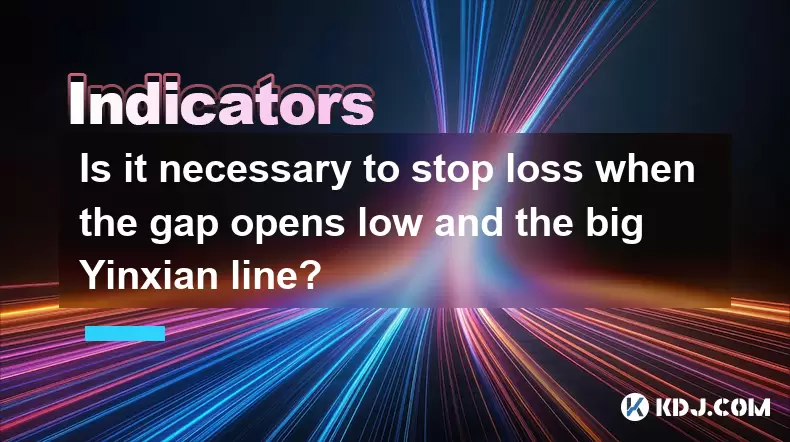
Understanding the Concept of Gaps in Cryptocurrency Trading
In cryptocurrency trading, gaps refer to areas on a price chart where no trading activity has occurred. These usually appear between the closing price of one candlestick and the opening price of the next. In traditional markets, gaps often occur due to news or events that happen outside regular trading hours. However, in the crypto market, which operates 24/7, gaps are less frequent but still possible during sudden market crashes or sharp volatility.
When traders talk about a gap opening low, they mean that after a period of consolidation or rising prices, the next candle opens significantly lower than the previous close. This can indicate strong selling pressure and a potential shift in market sentiment.
Gaps in crypto charts are not as common as in stock markets, but when they do appear, especially with large bearish candles, they can signal significant shifts in trader psychology.
The Significance of Big Yinxian Lines in Technical Analysis
A big Yinxian line is a Japanese candlestick pattern indicating strong bearish momentum. It appears as a long red (or black) candle with minimal upper and lower wicks, showing that sellers dominated the session from start to finish. When this type of candle appears at key resistance levels or after a strong uptrend, it is often interpreted as a reversal signal.
In the context of a gap down opening, a big Yinxian line reinforces the bearish scenario. Traders may interpret this combination as a warning sign for further downside movement. The psychological impact of such patterns should not be underestimated, especially in highly speculative markets like cryptocurrencies.
The presence of a large bearish candle immediately following a gap down can amplify the urgency for risk management actions, including stop loss placement.
Why Stop Loss Placement Matters in Crypto Volatility
Cryptocurrencies are known for their high volatility. Price swings of 10% or more within a single trading session are not uncommon. Without proper stop loss orders, traders can face significant losses quickly. A stop loss is an automated order that closes a trade once the price reaches a certain level, helping to limit potential losses.
When a gap opens low and is followed by a big Yinxian line, the probability of continued downward movement increases. At this point, having a stop loss in place becomes crucial, particularly if the trader entered a long position before this bearish setup formed.
- Set your stop loss just below the lowest point of the Yinxian candle to protect against further downside.
- Use a trailing stop loss if you believe the trend might continue but want to lock in profits.
- Avoid placing stop losses too tightly, especially in volatile crypto markets, to prevent premature exits.
Technical Indicators That Support Stop Loss Decisions
Traders often combine candlestick patterns with technical indicators to make more informed decisions regarding stop loss placement. Popular tools include:
- Moving Averages: If the price breaks below key moving averages (like the 50-day or 200-day MA), it could justify tightening or activating a stop loss.
- Relative Strength Index (RSI): An RSI reading below 30 indicates oversold conditions, while above 70 suggests overbought. In a gap-down scenario with a big Yinxian line, an RSI drop below 40 might confirm weakness.
- Volume Analysis: A surge in volume accompanying the bearish gap and candle adds credibility to the bearish move and supports aggressive stop loss execution.
Using multiple technical indicators alongside candlestick analysis helps traders avoid emotional decision-making and enhances the accuracy of stop loss placements.
How to Adjust Position Size Based on Gap and Candlestick Patterns
Position sizing plays a critical role in managing risk, especially when unexpected patterns like a gap down and big Yinxian line emerge. Properly adjusting your position size based on market structure and volatility ensures that even if the worst-case scenario unfolds, your account remains intact.
Here’s how to approach it:
- Reduce position size when entering trades near resistance levels or ahead of major news events.
- Increase caution when trading breakouts that lack confirmation from volume or other indicators.
- Reassess entry points if a gap occurs without clear reason or catalyst, as it might be a false move.
Smaller positions allow for tighter stop losses without risking a substantial portion of capital, especially in uncertain setups involving gaps and bearish candles.
Frequently Asked Questions
Q1: Can a gap up also be dangerous for short positions?
Yes, a gap up can be risky for short sellers because it can trigger automatic buy-ins or force liquidations. Shorting into a strong gap up without protective stop losses can lead to significant losses, especially in crypto markets prone to pump-and-dump behavior.
Q2: How far should I place my stop loss from the Yinxian candle?
Ideally, your stop loss should be placed slightly beyond the lowest shadow of the bearish candle. For example, if the candle's low is $30,000, placing the stop at $29,800 gives room for minor fluctuations while still protecting against major downside.
Q3: Should I always exit completely when a big Yinxian line appears after a gap down?
Not necessarily. Some experienced traders use this as a re-entry opportunity for short-term trades. However, for most retail traders, especially beginners, exiting partially or fully is safer unless there’s a clear counter-trend strategy in place.
Q4: Are gaps in crypto markets reliable signals for reversals?
Gaps in crypto are relatively rare and can sometimes be misleading. Their reliability improves when combined with strong candlestick patterns like the big Yinxian line and supported by volume spikes or fundamental triggers like negative news.
Disclaimer:info@kdj.com
The information provided is not trading advice. kdj.com does not assume any responsibility for any investments made based on the information provided in this article. Cryptocurrencies are highly volatile and it is highly recommended that you invest with caution after thorough research!
If you believe that the content used on this website infringes your copyright, please contact us immediately (info@kdj.com) and we will delete it promptly.
- 2025-W Uncirculated American Gold Eagle and Dr. Vera Rubin Quarter Mark New Products
- 2025-06-13 06:25:13
- Ruvi AI (RVU) Leverages Blockchain and Artificial Intelligence to Disrupt Marketing, Entertainment, and Finance
- 2025-06-13 07:05:12
- H100 Group AB Raises 101 Million SEK (Approximately $10.6 Million) to Bolster Bitcoin Reserves
- 2025-06-13 06:25:13
- Galaxy Digital CEO Mike Novogratz Says Bitcoin Will Replace Gold and Go to $1,000,000
- 2025-06-13 06:45:13
- Trust Wallet Token (TWT) Price Drops 5.7% as RWA Integration Plans Ignite Excitement
- 2025-06-13 06:45:13
- Ethereum (ETH) Is in the Second Phase of a Three-Stage Market Cycle
- 2025-06-13 07:25:13
Related knowledge
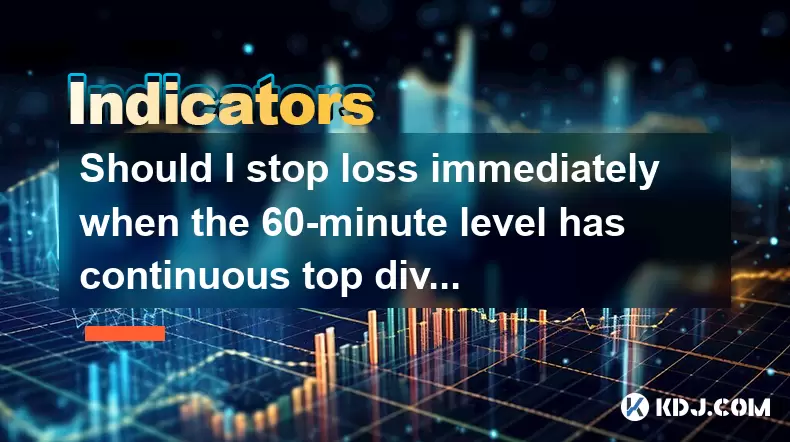
Should I stop loss immediately when the 60-minute level has continuous top divergence?
Jun 17,2025 at 05:28pm
Understanding Top Divergence in the 60-Minute ChartIn cryptocurrency trading, top divergence refers to a technical signal where the price of an asset makes higher highs while the indicator (often RSI or MACD) makes lower lows. This is commonly interpreted as a sign of weakening momentum and potential reversal. When this occurs on the 60-minute chart, it...
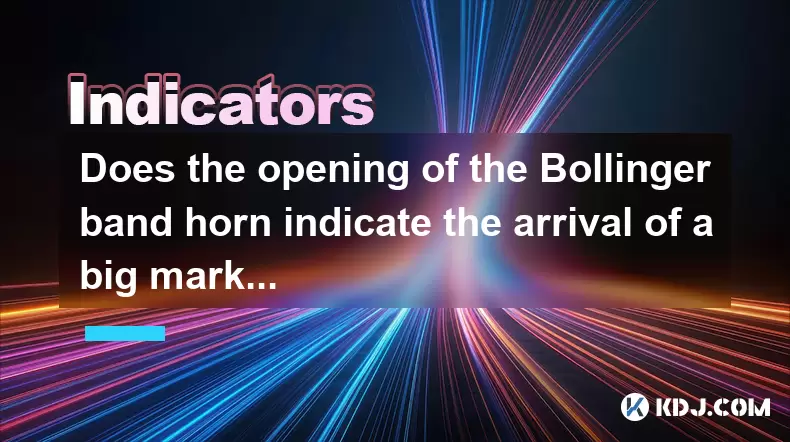
Does the opening of the Bollinger band horn indicate the arrival of a big market?
Jun 17,2025 at 06:28pm
Understanding the Bollinger Bands and Their StructureBollinger Bands are a widely used technical analysis tool in the cryptocurrency market, developed by John Bollinger. They consist of three lines: a simple moving average (SMA), typically set at 20 periods, and two standard deviation bands above and below this SMA. These bands dynamically expand and co...
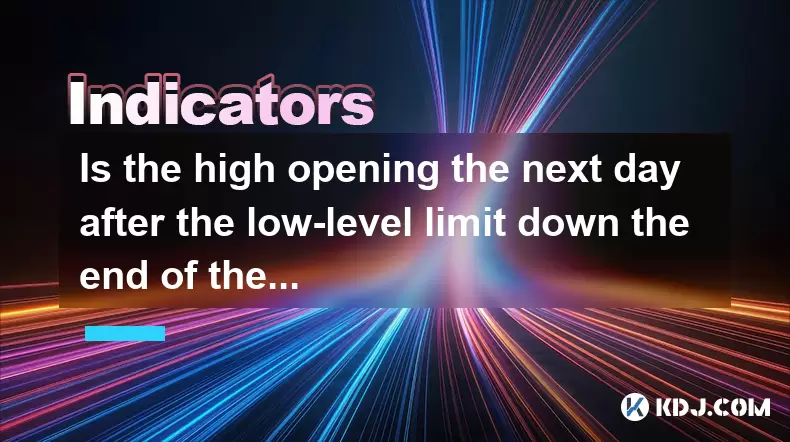
Is the high opening the next day after the low-level limit down the end of the wash?
Jun 17,2025 at 05:57pm
Understanding the Concept of a Limit Down and Its ImplicationsIn the world of cryptocurrency trading, a limit down refers to a situation where the price of a digital asset drops sharply, reaching its maximum allowable decline within a specific time frame. This mechanism is often seen on exchanges that implement daily price limits to prevent excessive vo...
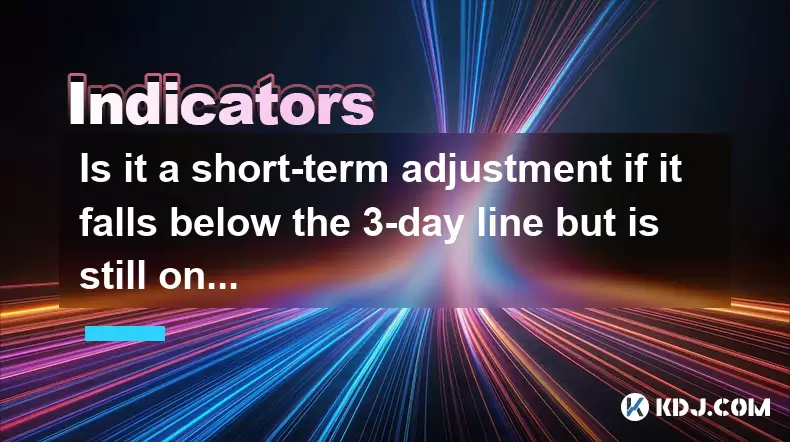
Is it a short-term adjustment if it falls below the 3-day line but is still on the 10-day line?
Jun 17,2025 at 04:07pm
Understanding the 3-Day and 10-Day Moving AveragesIn cryptocurrency trading, moving averages are essential tools for gauging trend strength and potential reversals. The 3-day moving average is a short-term indicator that reflects recent price action with minimal lag, making it highly sensitive to sudden market shifts. In contrast, the 10-day moving aver...
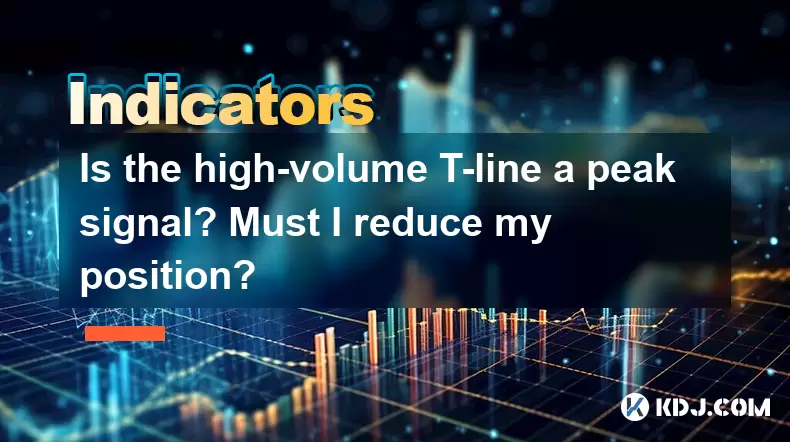
Is the high-volume T-line a peak signal? Must I reduce my position?
Jun 17,2025 at 06:07pm
Understanding the T-Line Pattern in Cryptocurrency TradingIn cryptocurrency trading, technical patterns are frequently used by traders to anticipate price movements. One such pattern is the T-line, which appears on candlestick charts and is characterized by a long upper or lower shadow with little or no body. A high-volume T-line occurs when this patter...
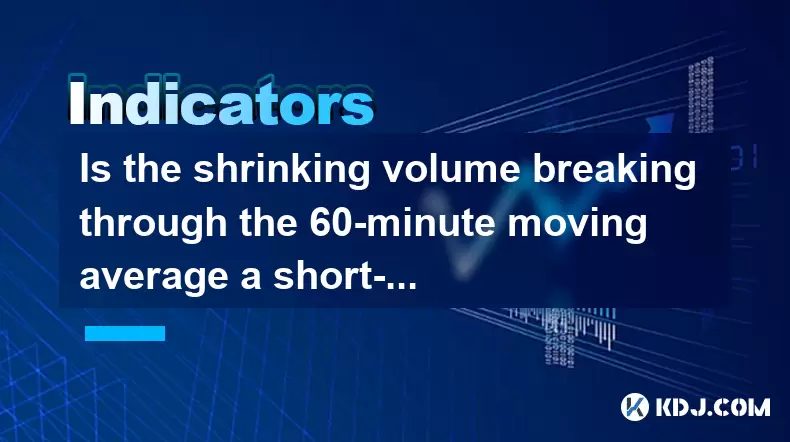
Is the shrinking volume breaking through the 60-minute moving average a short-term weakness? Should I run?
Jun 17,2025 at 06:21pm
Understanding the 60-Minute Moving Average in Cryptocurrency TradingIn cryptocurrency trading, the 60-minute moving average is a popular technical indicator used by traders to assess short-term trends. This metric calculates the average price of an asset over the last 60 minutes and updates with each passing minute. Traders often use it to identify pote...

Should I stop loss immediately when the 60-minute level has continuous top divergence?
Jun 17,2025 at 05:28pm
Understanding Top Divergence in the 60-Minute ChartIn cryptocurrency trading, top divergence refers to a technical signal where the price of an asset makes higher highs while the indicator (often RSI or MACD) makes lower lows. This is commonly interpreted as a sign of weakening momentum and potential reversal. When this occurs on the 60-minute chart, it...

Does the opening of the Bollinger band horn indicate the arrival of a big market?
Jun 17,2025 at 06:28pm
Understanding the Bollinger Bands and Their StructureBollinger Bands are a widely used technical analysis tool in the cryptocurrency market, developed by John Bollinger. They consist of three lines: a simple moving average (SMA), typically set at 20 periods, and two standard deviation bands above and below this SMA. These bands dynamically expand and co...

Is the high opening the next day after the low-level limit down the end of the wash?
Jun 17,2025 at 05:57pm
Understanding the Concept of a Limit Down and Its ImplicationsIn the world of cryptocurrency trading, a limit down refers to a situation where the price of a digital asset drops sharply, reaching its maximum allowable decline within a specific time frame. This mechanism is often seen on exchanges that implement daily price limits to prevent excessive vo...

Is it a short-term adjustment if it falls below the 3-day line but is still on the 10-day line?
Jun 17,2025 at 04:07pm
Understanding the 3-Day and 10-Day Moving AveragesIn cryptocurrency trading, moving averages are essential tools for gauging trend strength and potential reversals. The 3-day moving average is a short-term indicator that reflects recent price action with minimal lag, making it highly sensitive to sudden market shifts. In contrast, the 10-day moving aver...

Is the high-volume T-line a peak signal? Must I reduce my position?
Jun 17,2025 at 06:07pm
Understanding the T-Line Pattern in Cryptocurrency TradingIn cryptocurrency trading, technical patterns are frequently used by traders to anticipate price movements. One such pattern is the T-line, which appears on candlestick charts and is characterized by a long upper or lower shadow with little or no body. A high-volume T-line occurs when this patter...

Is the shrinking volume breaking through the 60-minute moving average a short-term weakness? Should I run?
Jun 17,2025 at 06:21pm
Understanding the 60-Minute Moving Average in Cryptocurrency TradingIn cryptocurrency trading, the 60-minute moving average is a popular technical indicator used by traders to assess short-term trends. This metric calculates the average price of an asset over the last 60 minutes and updates with each passing minute. Traders often use it to identify pote...
See all articles

























































































